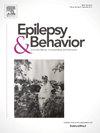结节性硬化综合征早期癫痫发作治疗策略的演变:回顾与治疗算法。
IF 2.3
3区 医学
Q2 BEHAVIORAL SCIENCES
引用次数: 0
摘要
结节性硬化综合征(TSC)是一种遗传性疾病,其特点是多系统受累,80%-90%的患者会患上癫痫,而且通常在婴儿期就开始发作。TSC患者的早期癫痫发作与不良的神经发育预后有关,这凸显了及时有效治疗的重要性。本综述探讨了幼儿TSC相关性癫痫发作不断发展的治疗前景,重点关注最近获批或扩大许可的三种疗法:维格巴曲林、依维莫司和大麻二酚。根据临床试验和实际证据对这些疗法的疗效和安全性进行了研究,重点关注它们在治疗幼儿癫痫发作中的应用。此外,还仔细回顾了在临床研究中抢先使用维加巴曲林的情况。本文提出了一种治疗算法,强调早期诊断、及时开始适当的治疗,并采用循序渐进的方法来控制婴儿痉挛症和局灶性癫痫发作。该算法将这些新疗法与传统的抗癫痫药物和非药物疗法结合起来。文中讨论了在优化治疗策略、减少副作用和改善长期疗效方面所面临的挑战。本综述旨在指导临床医生驾驭与 TSC 相关的早期癫痫发作的复杂局面,最终为改善这一弱势群体的癫痫发作控制和发育预后而努力。本文章由计算机程序翻译,如有差异,请以英文原文为准。
Evolving treatment strategies for early-life seizures in Tuberous Sclerosis Complex: A review and treatment algorithm
Tuberous sclerosis Complex (TSC) is a genetic disorder characterized by multisystem involvement, with epilepsy affecting 80–90% of patients, often beginning in infancy. Early-life seizures in TSC are associated with poor neurodevelopmental outcomes, underscoring the importance of timely and effective management. This review explores the evolving treatment landscape for TSC-associated seizures in young children, focusing on three recently approved or license-expanded therapies: vigabatrin, everolimus, and cannabidiol. The efficacy and safety profiles of these treatments are examined based on clinical trials and real-world evidence, with a focus on their use in treating seizures in young children. The preemptive use of vigabatrin in clinical studies has also been carefully reviewed. A treatment algorithm is proposed, emphasizing early diagnosis, prompt initiation of appropriate therapy, and a stepwise approach to managing both infantile spasms and focal seizures. The algorithm incorporates these newer therapies alongside traditional antiseizure medications and non-pharmacological approaches. Challenges in optimizing treatment strategies, minimizing side effects, and improving long-term outcomes are discussed. This review aims to guide clinicians in navigating the complex landscape of early-life seizures associated with TSC, ultimately striving for improved seizure control and better developmental outcomes in this vulnerable population.
求助全文
通过发布文献求助,成功后即可免费获取论文全文。
去求助
来源期刊

Epilepsy & Behavior
医学-行为科学
CiteScore
5.40
自引率
15.40%
发文量
385
审稿时长
43 days
期刊介绍:
Epilepsy & Behavior is the fastest-growing international journal uniquely devoted to the rapid dissemination of the most current information available on the behavioral aspects of seizures and epilepsy.
Epilepsy & Behavior presents original peer-reviewed articles based on laboratory and clinical research. Topics are drawn from a variety of fields, including clinical neurology, neurosurgery, neuropsychiatry, neuropsychology, neurophysiology, neuropharmacology, and neuroimaging.
From September 2012 Epilepsy & Behavior stopped accepting Case Reports for publication in the journal. From this date authors who submit to Epilepsy & Behavior will be offered a transfer or asked to resubmit their Case Reports to its new sister journal, Epilepsy & Behavior Case Reports.
 求助内容:
求助内容: 应助结果提醒方式:
应助结果提醒方式:


